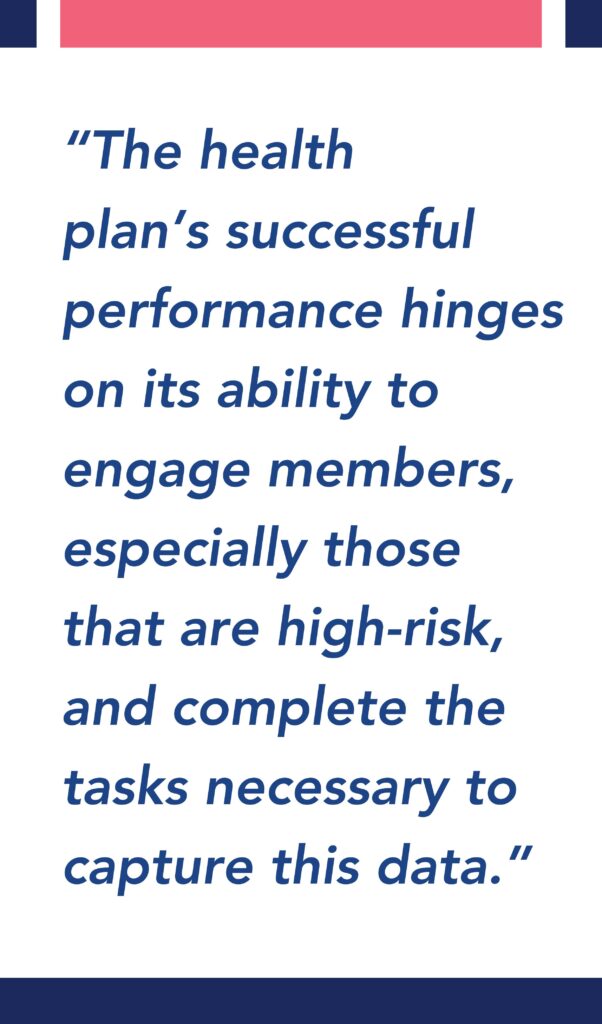Published on .
Successful performance in the Medicare Advantage environment is definitely a marathon, not a sprint—one that covers challenging, uneven terrain with plenty of hurdles thrown in. Each year, plans are faced with the need for successful performance on the CMS Star Ratings to continue to remain profitable and are tasked with keeping tabs on health risks associated with members’ health status for accurate risk assessment. As MA plans run the race to the finish each year, vying for a portion of the financial incentives available for high performance, they often stumble during the last mile: engaging the highest risk, most complex and least-involved Medicare members in personalized, comprehensive, high-quality care.
These high-risk members are typically among the most costly, the least adherent to medications and the most likely to experience avoidable utilization, all of which can have a major negative impact on highly weighted Star Ratings measures that are directly tied to incentive opportunities.
To succeed with their overall goals, it is imperative that MA plans accurately identify high-risk members, gain insight into their challenges and opportunities, and proactively engage with these individuals to close gaps in care before the end of the performance period.

Data is the key to leading the pack across the finish line. With the right data capture and analytics capabilities, MA plans can generateaccurate, holistic portraits of their highest-risk populations, which serves multiple functions. First, data can be used to empower the efforts of outreach clinicians to deploy targeted interventions that improve member adherence with healthy behaviors and medications (for improved Star Ratings). And second, it can assist in completing health risk assessments (HRAs) and the survey associated with the new SNS-E Star Ratings measure, or in helping high-risk members schedule valuable screenings, such as annual wellness visits (AWVs).
Turning data into fuel for a more comprehensive engagement ecosystem
Much like carbs for the marathon runner, data is the fuel to help MA plans stay on a winning pace throughout the year. Datapoints such as demographics, health status, health risk factors, functions of daily living and socioeconomic barriers are essential for identifying people at risk of negative events that could benefit from timely interventions.
The health plan’s successful performance hinges on its ability to engage members, especially those that are high-risk, and complete the tasks necessary to capture this data. This may include:
- A conversation with an outreach clinician to understand and resolve social determinants of health (SDOH) barriers
- Completion of the survey for the Social Needs Screening and Intervention (SNS-E) HEDIS measure
- Completion of an HRA, which can be used to generate ICD-10 codes for risk scoring and risk adjustment
These activities can lead to a variety of positives for health plans, including overall higher Star Ratings by closing care gaps quickly, improving member experiences, assessing risk and helping plans establish meaningful relationships with the highest-risk Medicare members who may need extra assistance with ongoing challenges, such as maintaining medication adherence.
The pressing need to gain insight into the challenges of high-risk MA members
Just over half of all Medicare beneficiaries are enrolled in an MA plan instead of the traditional fee-for-service (FFS) Medicare option. Compared to FFS enrollees, MA members are more likely to experience clinical and social risk factors, including being more likely to experience multiple chronic conditions.
For example, a recent study from Avalere and the Better Medicare Alliance found that 28.8% of MA plan members are living with hypertension, hyperlipidemia and diabetes all at once, compared to 23.7% of the FFS population.
At the same time, separate research from CMS found that dual-eligible (DE) MA members and those receiving a low income subsidy (LIS)—a powerful proxy for socioeconomic vulnerability—are significantly more likely than higher income peers to experience gaps in important health screenings and services, including lower rates of cancer screenings, medication adherence and reconciliation, or follow-up after a transition of care.
The overlap of these populations often represents the most challenging group for MA plans to engage and manage. These high-risk members may not have the financial resources, health literacy or social support to actively participate in their care, creating the risk of poor outcomes and high costs.
Unfortunately, many MA plans also lack the capacity to effectively connect with and engage the highest-risk Medicare members. And visibility into the challenges of high-risk, complex members is more important now than ever, especially given the advent of the Health Equity Index (HEI) from CMS, specifically designed to reduce disparities for the most vulnerable MA members.
To successfully achieve their goals, MA plans are tasked with engaging high-risk members to capture valuable health and SDOH data, and track completion of healthy behaviors associated with higher performance on Stars measures.
To learn more about how to engage the “engageable” with advanced analytics and an SDOH-first approach to engagement, register for our upcoming webinar.
Partnering to engage hard-to-reach, highest-risk Medicare members for data collection and personalized outreach
Successful connection with and engagement of high-risk, high-complexity members requires a degree of investment from MA plans. First, plans will need to be able to identify members for outreach. Second, they’ll need the right connection and engagement strategies to get high-risk members on the phone, collect any health information the member may share, and uncover and resolve any SDOH challenges the member may be facing as a hurdle to healthy behaviors, such as filling prescriptions or attending a wellness visit. While plans can certainly commit to building the necessary data infrastructure in-house and training outreach clinicians to effectively connect with everyone on their priority list, it often makes more sense to bring on a partner with established skills and resources instead.
The right partner will give plans access to a “one-stop shop” for analytics and engagement, leveraging a robust data-driven platform backed by deep experience in working with challenging populations to target the right individuals, collect important data, complete screenings and make a positive impact on members’ abilities to self-manage their health.
A high-value partner will take on the full engagement cycle with an initial focus on those “unengagable” members with the highest-priority risk factors. Throughout the process, trained outreach staff will be able to:
- Target at-risk members using advanced analytics and predictive models to identify individuals with rising risks, known gaps in care, or missing screenings tied to plan goals.
- Connect with hard-to-reach members through proven techniques, such as multi-modal outreach capabilities via preferred contact channels, using the member’s language of choice, and clearly stating the purpose for the conversation up front.
- Reduce member abrasion by maximizing the productivity of each engagement, such as using the same call to complete an HRA, ask the right questions for the SNS-E measure, and schedule the member’s next AWV during a single interaction.
- Build trusted, long-term relationships with members through proven techniques, such as motivational interviewing, and taking real-time action to begin resolving socioeconomic barriers alongside community partners.
- Collect structured, meaningful insights into socioeconomic barriers that can be translated into Z-codes for appropriate risk adjustment and future pattern recognition.
With the knowledge, support and expertise of a dedicated engagement partner, MA plans can gain access to the data they need to effectively complete their performance goals.
By developing stronger relationships with high-risk, difficult-to-reach individuals and remaining one step ahead of common issues that could lead to poor experiences and outcomes, MA plans will be able to care for their most challenging populations while achieving their Star Ratings goals.
Taking this proactive, data-driven approach can mean the difference between being first to the finish line—or being a straggler bringing up the rear. With so much at stake for MA plans in this highly competitive, incentive-driven environment, plans need to choose the right strategies and the best possible partners to make sure they are making it to the winner’s circle after each year’s performance period.
To learn more about AdhereHealth’s holistic approach to data collection and improved adherence with medication and healthy behaviors, contact us today!
 Authored by:
Authored by:
Glenn Wirick
Office of the President, AdhereHealth
